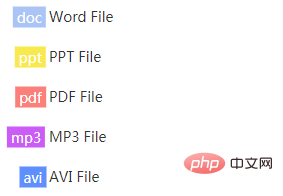What is the use of css attribute selector?
The attribute selector of css can find elements with specific attributes or specific value attributes, that is, you can match HTML elements by existing attribute names or attribute values, and then set styles for HTML elements with specified attributes. .

Elements in HTML can have attributes, which are additional values that display or modify their behavior. HTML contains many attributes, but not all attributes are applicable to all HTML elements. Properties unrelated to the element have no effect on it.
Regardless of whether the property is applied correctly, you can still select it via CSS. However, using invalid HTML attributes anywhere on your website is a very bad practice because different browsers interpret invalid HTML differently. You can't blame the browser for making your site look weird, they're just trying to explain your error code by filling in the gaps.
However, the CSS attribute selector allows us to select elements with specific attributes or specific value attributes, that is: we can find the corresponding HTML element based on the specified attribute name, and then set the CSS style .
Related recommendations: "HTML Video Tutorial", "CSS Video Tutorial"
CSS attribute selector, you can Match elements by existing attribute names or attribute values. Attribute selectors were introduced in CSS2 and well-extended in CSS3. This article will introduce the attribute selector in a more comprehensive way, and try to explore the different uses of this selector in different scenarios.
Simple syntax introduction
- [attr]: This selector selects all items containing the attr attribute element, regardless of the value of attr.
- [attr=val]: This selector only selects all elements whose attr attribute is assigned the value val.
- [attr~=val]: This selector only selects elements with the attr attribute, and the val value is required to be one of the space-separated value lists contained in the attr value. .
Substring value attribute selector,
The following are new syntaxes in CSS3, also known as "pseudo-regular selectors" because they provide flexible matching methods similar to regular expressions.
- [attr|=val] : Select elements whose attr attribute value is val or whose value starts with val- (note that the "-" here is not an error, this is used to handle language encoding).
- [attr^=val] : Select elements whose attr attribute value starts with val (including val).
- [attr$=val] : Select elements whose attr attribute value ends with val (including val).
- [attr*=val] : Select elements whose attr attribute value contains the substring val (a substring is just a part of a string, for example, "cat" Is a substring of the string "caterpillar"
The most basic usage of CSS attribute selector
The most basic usage of the attribute selector is to select DOM elements through the element's attribute value. Like this, all DOM elements with href attributes will be selected:
[href] {
color: red;
}CodePen Demo -- Basic usage of attribute selector
https://codepen.io/Chokcoco/pen/qGGxYa
A little more complicated usage
Cascading selection
p [href]{
...
}Multi-condition compound selection
Select an img tag that contains the title attribute and an element with the class name logo.
img[title][class~=logo]{
...
}伪正则写法
i参数
忽略类名的大小写限制,选择包含 class 类名包含子字符串为 text,Text,TeXt... 等情况的 p 元素。 这里的 i 的含义就是正则里面参数 i 的含义,ignore,忽略大小写的意思。
p[class*="text" i] {
...
}所以上面的选择器可以选中类似这样的目标元素:
<p class="text"></p> <p class="nameText"></p> <p class="desc textarea"></p>
g参数
与正则表达式不一样,参数 g 在这里表示大小写敏感(case-sensitively)。然而,这个属性当前仍未纳入标准,支持的浏览器不多。
CodePen Demo -- 属性选择器的伪正则用法
https://codepen.io/Chokcoco/pen/rggdYj
配合<strong><span style="font-family: verdana, geneva;"> </span></strong><strong><span style="font-family: verdana, geneva;">:not()</span></strong><strong><span style="font-family: verdana, geneva;"></span></strong> 伪类
还有一种比较常用的场景就是搭配:not() 伪类,完成一些判断检测性的功能。譬如下面这个选择器,就可以选取所有没有 [href] 属性的 a 标签,添加一个红色边框。
a:not([href]){
border: 1px solid red;
}当然,复杂一点,我们可以搭配不仅仅一个 :not()伪类,像是这样,可以同时多个配合使用,选择一个 href, target, rel 属性都没有的 a 标签:
a:not([href]):not([target]):not([rel]){
border: 1px solid blue;
}CodePen Demo -- 属性选择器配合 :not 伪类
https://codepen.io/Chokcoco/pen/JQdgzR
重写行内样式?
甚至乎,如果有这种场景,我们还可以覆盖掉行内样式,像这样:
<p style="height: 24px; color: red;">xxxxxx</p>
我们可以使用属性选择器强制覆盖掉上述样式:
[style*="color: red"] {
color: blue !important;
}组合拳用法,搭配伪元素提升用户体验
当然,属性选择器不一定只是单单的进行标签的选择。
配合上伪元素,我们可以实现很多有助提升用户体验的功能。
角标功能
这里有一个小知识点,伪元素的 content 属性,通过 attr(xxx),可以读取到对应 DOM 元素标签名为 xxx 的属性的值。
所以,配合属性选择器,我们可以很容易的实现一些角标功能:
<p count=“5“>Message</p>
p {
position: relative;
width: 200px;
height: 64px;
}
p::before {
content: attr(count);
...
}
这里右上角的数字 5 提示角标,就是使用属性选择器配合伪元素实现,可以适应各种长度,以及中英文,能够节省一些标签。
CodePen Demo -- 属性选择器实现角标功能
https://codepen.io/Chokcoco/pen/EBKMpw
属性选择器配合伪元素实现类 title 功能
我们都知道,如果给一个图片添加一个 title 属性,当 hover 到图片上面的时,会展示 title 属性里面附加的内容,类似这样:
<img src="/static/imghw/default1.png" data-src="xxxxxxxxx" class="lazy" title="风景图片" alt="What is the use of css attribute selector?" >

这里不一定是 img 标签,其他标签添加 title 属性都能有类似的效果。但是这里会有两个问题:
- 响应太慢,通常鼠标 hover 上去要隔 1s 左右才会出现这个 title 框
- 框体结构无法自定义,弹出框的样式无法自定义
所以这里,如果我们希望有一些自己能够控制样式的可快速响应的浮层,可以自定义一个类 title 属性,我们把它称作 popTitle,那么可以这样操作:
<p class="title" popTitle="文字弹出">这是一段描述性文字</p> <p class="title" popTitle="标题A">这是一段描述性文字</p>
p[popTitle]:hover::before {
content: attr(popTitle);
position: absolute;
color: red;
border: 1px solid #000;
...
}对比一下,第一个是原生自带的 title 属性,下面两个是使用属性选择器配合伪元素模拟的提示:

浏览器自带的
title属性延迟响应是添加一层防抖保护,避免频繁触发,这里也可以通过对伪元素添加一个100毫秒级的transition-delay实现延迟展示。
CodePen Demo -- 属性选择器配合伪元素实现类 title 功能
https://codepen.io/Chokcoco/pen/GaaXyp
商品展示提示效果
好,上面的运用实例我们再拓展一下,考虑如何更好的运用到实际业务中,其实也是有很多用武之地的。譬如说,通过属性选择器给图片添加标签,类似一些电商网站会用到的一个效果。
我们希望给图片添加一些标签,在 hover 图片的时候展示出来。
当然,CSS 中,诸如
<img src="/static/imghw/default1.png" data-src="https://xx.baidu.com/timg?xxx" class="lazy" alt="What is the use of css attribute selector?" >、<input>、<iframe>,这几个标签是不支持伪元素的。
所以这里我们输出 DOM 的时候,给 img 的父元素带上部分图片描述标签。通过 CSS 去控制这些标签的展示:
<p class="g-wrap" desc1="商品描述AAA" desc2="商品描述BBB">
<img src="/static/imghw/default1.png" data-src="https://xx.baidu.com/timg?xxx" class="lazy" alt="What is the use of css attribute selector?" >
</p>[desc1]::before,
[desc2]::after {
position: absolute;
opacity: 0;
}
[desc1]::before {
content: attr(desc1);
}
[desc2]::after {
content: attr(desc2);
}
[desc1]:hover::before,
[desc2]:hover::after{
opacity: 1;
}看看效果:

CodePen Demo -- 通过属性选择器给图片添加标签
https://codepen.io/Chokcoco/pen/VJZKmx?editors=1100
属性选择器配合伪元素实现下载提示
我们知道,HTML5 对标签新增了一个 download 属性,此属性指示浏览器下载 URL 而不是导航到它。
那么,我们可以利用属性选择器对所有带此类标签的元素进行提示。像这样:
<a href="https://www.xxx.com/logo.png" download="logo">logo</a>
[download] {
position: relative;
color: hotpink;
}
[download]:hover::before {
content: "点击可下载此资源!";
position: absolute;
...
}当我们 hover 到这个链接的时候,就会这样,提示用户,这是一个可以下载的按钮:

CodePen Demo -- 属性选择器配合伪元素做下载提示
https://codepen.io/Chokcoco/pen/byymKj
属性选择器配合伪元素对链接的协议进行提示(http/https)
现在大部分网站不是切了 https 就是走在切 https 的路上。如果页面上的链接很多或者对跳转页面的协议有要求,使用属性选择器配合伪元素对链接的协议进行提示也不失为一种好方法。
a[href^="http:"]:hover::before {
content: "这是一个http链接";
...
}
a[href^="https:"]:hover::before {
content: "这是一个https链接";
}CodePen Demo -- 属性选择器配合伪元素对链接的协议进行提示(http/https)
https://codepen.io/Chokcoco/pen/byXQwj
当然,伪元素的内容不一定是纯文字的,为了给用户更好的体验,图或者图片加文字也是可以的。
譬如我们可以形象化地给 https 链接站点再加一个小绿锁,符合用户的一些常规认知。

这里我将小绿锁的图片使用 base64 嵌入到伪元素当中,简单的使用 text-indent 控制图文的排布:
a[href^="https:"]:hover::before {
content: "";
padding-left: 16px;
background: url("data:image/png;base64,iVBORw0KGgoAAAANSUhEUgAAAAwAAAAMCAYAAABWdVznAAAACXBIWXMA
AA7EAAAOxAGVKw4bAAAAb0lEQVQoz2NkQAJc5aIc//7962VgYIiDCi1iYmIq/tb5+gdMDROyBqhiGWYmJlVmJiZVBgYGGagYds
BRKvyZu1xUAsbnLheV4CgV/oxbQ4nwf0JiTAwkAkaIU4QaGf4z1uFX+b/pR/e7epJtGJEaAKDXHzEJ3KYmAAAAAElFTkSuQmCC");
...
}
这里只是一个非常小的 Demo,实际情况是大部分用户并不了解这个小绿锁的含义,所以实际使用应该搭配文字辅助提示。
CodePen Demo -- 属性选择器配合伪元素对https协议进行图文提示
https://codepen.io/Chokcoco/pen/wbVQJx
属性选择器对文件类型的处理
也可以对一些可下载资源进行视觉上 icon 的提示。
<ul>
<li><a href="xxx.doc">Word File</a></li>
<li><a href="xxx.ppt">PPT File</a></li>
<li><a href="xxx.PDF">PDF File</a></li>
<li><a href="xxx.MP3">MP3 File</a></li>
<li><a href="xxx.avi">AVI File</a></li>
</ul>a[href$=".doc" i]::before {
content: "doc";
background: #a9c4f5;
}
a[href$=".ppt" i]::before {
content: "ppt";
background: #f8e94f;
}
a[href$=".pdf" i]::before {
content: "pdf";
background: #fb807a;
}
a[href$=".mp3" i]::before {
content: "mp3";
background: #cb5cf5;
}
a[href$=".avi" i]::before {
content: "avi";
background: #5f8ffc;
}
CodePen Demo -- 属性选择器选择文件名后缀
https://codepen.io/Chokcoco/pen/orNQJL
属性选择器对 input 类型的处理
属性选择器其实对 input 类型的元素是一个很好的帮手,因为 input 常用,且经常搭配很多不同功能的属性值。
只不过,由于 input 类型无法添加伪元素。所以搭配属性选择器更多的通过属性的各种状态改变自身的样式。
简单举个例子,譬如:
<input type="text"> <input type="text" disabled>
input[type=text][disabled] {
border: 1px solid #aaa;
background: #ccc;
}这里,我们选择了 type=text 并且拥有 disabled 属性的 input 元素,将它的背景色和边框色设置为灰色。给与用户更好的视觉提示。

值得注意的点
注意选择器优先级 ,.class 与 [class=xxx] 是否等价
考虑这个问题,下面两个选择器是否等值?
<p class="header">
.header {
color: red;
}
[class~="header"] {
color: blue;
}上述两个选择器,作用完全一致。然而,如果是下面这种情况,两者就不一样了:
<p id="header">
#header{
color: red;
}
[id="header"] {
color: blue;
}这里,ID 选择器#header比属性选择器[id="header"]的权重更高,虽然两者能够选择同样的元素,但是两者并不完全等价。
是否需要引号?
考虑下面三种情况,是否一致?
[class="header"]{ ... }
[class='header']{ ... }
[class=header]{ ... }事实上,从 HTML2 开始,不添加引号的写法就已经得到支持,所以上述三种写法都是正确的。
然而,能够不使用引号也是有限制的,再看看下面这种写法:
a[href=bar] { ... }
a[href^=http://] {... }第二个选择器是个无效选择器,:// 不括起来的话会识别错误,必须使用引号引起来像这样a[href^="http://"],这里具体的原因可以看看这篇文章:Unquoted attribute value validator。
所以保险起见,建议都加上引号。
CSS 语义化
编写”具有语义的HTML”原则是现代、专业前端开发的一个基础。当然,我们经常谈论到的都是 HTML 语义化。
那么,CSS 需要语义化吗?CSS 有语义化吗?例如上述的例子,使用特定的类名或者 id 选择器皆可完成。那么使用属性选择器的理由是什么?
我的理解是,属性(attribute)本身已经具有一定的语义,表达了元素的某些特征或者功能,利用属性选取元素再进行对该属性值的特定操作,一定程度上也可以辅助提升代码的语义化。至少的提升了 CSS 代码的可读性。但是 CSS 是否需要语义化这个问题就见仁见智了。
更多编程相关知识,请访问:编程视频课程!!
The above is the detailed content of What is the use of css attribute selector?. For more information, please follow other related articles on the PHP Chinese website!

Hot AI Tools

Undresser.AI Undress
AI-powered app for creating realistic nude photos

AI Clothes Remover
Online AI tool for removing clothes from photos.

Undress AI Tool
Undress images for free

Clothoff.io
AI clothes remover

AI Hentai Generator
Generate AI Hentai for free.

Hot Article

Hot Tools

Notepad++7.3.1
Easy-to-use and free code editor

SublimeText3 Chinese version
Chinese version, very easy to use

Zend Studio 13.0.1
Powerful PHP integrated development environment

Dreamweaver CS6
Visual web development tools

SublimeText3 Mac version
God-level code editing software (SublimeText3)

Hot Topics
 What does placeholder mean in vue
May 07, 2024 am 09:57 AM
What does placeholder mean in vue
May 07, 2024 am 09:57 AM
In Vue.js, the placeholder attribute specifies the placeholder text of the input element, which is displayed when the user has not entered content, provides input tips or examples, and improves form accessibility. Its usage is to set the placeholder attribute on the input element and customize the appearance using CSS. Best practices include being relevant to the input, being short and clear, avoiding default text, and considering accessibility.
 What does span mean in js
May 06, 2024 am 11:42 AM
What does span mean in js
May 06, 2024 am 11:42 AM
The span tag can add styles, attributes, or behaviors to text. It is used to: add styles, such as color and font size. Set attributes such as id, class, etc. Associated behaviors such as clicks, hovers, etc. Mark text for further processing or citation.
 What does rem mean in js
May 06, 2024 am 11:30 AM
What does rem mean in js
May 06, 2024 am 11:30 AM
REM in CSS is a relative unit relative to the font size of the root element (html). It has the following characteristics: relative to the root element font size, not affected by the parent element. When the root element's font size changes, elements using REM will adjust accordingly. Can be used with any CSS property. Advantages of using REM include: Responsiveness: Keep text readable on different devices and screen sizes. Consistency: Make sure font sizes are consistent throughout your website. Scalability: Easily change the global font size by adjusting the root element font size.
 How to introduce images into vue
May 02, 2024 pm 10:48 PM
How to introduce images into vue
May 02, 2024 pm 10:48 PM
There are five ways to introduce images in Vue: through URL, require function, static file, v-bind directive and CSS background image. Dynamic images can be handled in Vue's computed properties or listeners, and bundled tools can be used to optimize image loading. Make sure the path is correct otherwise a loading error will appear.
 What is the function of span tag
Apr 30, 2024 pm 01:54 PM
What is the function of span tag
Apr 30, 2024 pm 01:54 PM
The SPAN tag is an inline HTML tag that is used to highlight text by applying attributes such as style, color, and font size. This includes emphasizing text, grouping text, adding hover effects, and dynamically updating content. It is used by placing <span> and </span> tags around the text you want to emphasize, and is manipulated via CSS styling or JavaScript. The benefits of SPAN tags include semantic clarity, styling flexibility, and ease of maintenance.
 How to wrap prompt in js
May 01, 2024 am 06:24 AM
How to wrap prompt in js
May 01, 2024 am 06:24 AM
When using the prompt() method in JavaScript, you can achieve line breaks through the following three methods: 1. Insert the "\n" character at the position where you want to break the line; 2. Use the line break character in the prompt text; 3. Use CSS's "white" -space: pre" style forces line breaks.
 What language is the browser plug-in written in?
May 08, 2024 pm 09:36 PM
What language is the browser plug-in written in?
May 08, 2024 pm 09:36 PM
Browser plug-ins are usually written in the following languages: Front-end languages: JavaScript, HTML, CSS Back-end languages: C++, Rust, WebAssembly Other languages: Python, Java
 What is node in js
May 07, 2024 pm 09:06 PM
What is node in js
May 07, 2024 pm 09:06 PM
Nodes are entities in the JavaScript DOM that represent HTML elements. They represent a specific element in the page and can be used to access and manipulate that element. Common node types include element nodes, text nodes, comment nodes, and document nodes. Through DOM methods such as getElementById(), you can access nodes and operate on them, including modifying properties, adding/removing child nodes, inserting/replacing nodes, and cloning nodes. Node traversal helps navigate within the DOM structure. Nodes are useful for dynamically creating page content, event handling, animation, and data binding.






